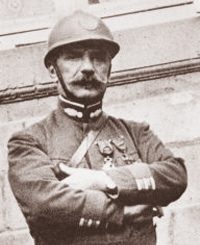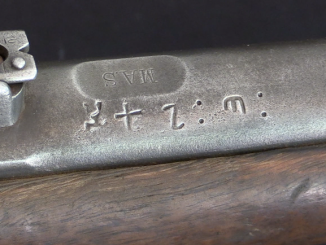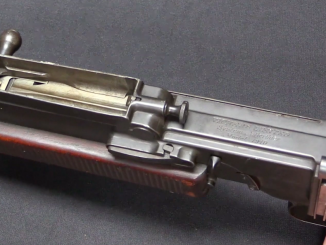The French RSC-1917 semiauto rifle was a major step forward in arms technology during World War One, offering a reliable and effective self-loading rifle for issue to squad leaders, expert marksmen, and other particularly experienced and effective troops. No other military was able to field a semiauto combat shoulder rifle during this was in anything but very limited numbers. However, the RSC-1917 definitely had some shortcomings:
- It was just too long, at the same size as the Lebel
- The specialized clip was a logistical problem
- The gas system was fragile and difficult to clean or disassemble
- The magazine cover was easily damaged
These issues were all addressed in the Model 1918 upgrade of the rifle, although it was too late to see active service in the Great War. The new pattern was substantially shorter (both the stock and barrel), it used the standard Berthier 5-round clip, it had a substantially strengthened magazine cover, and a much improved gas system.
Today, we will compare the various features of the 1917 and 1918 rifles, and disassemble the 1918 gas system to show how it worked. Special thanks to Paul for letting me use his rifles – check him out on Instagram!




“gas system was fragile and difficult to clean or disassemble”
Here is article about early French self-loading weapons:
http://www.smallarmsreview.com/display.article.cfm?idarticles=1822
About RSC 1917:
It was issued to the better marksmen who were additionally chosen for their mechanical abilities!
It also states about shortened RSC 1917, (“Model 1917”) carbine, which remain prototypes only.
After reading that
It [magazine for Meunier A6 rifle, firing 7 mm rimless cartridge] receives 6 cartridges. Ten- and fifteen-round magazine were also studied but not adopted.
I wonder what was reason for choice of that capacity for RSC 1917: doctrine XOR technical limitations (heavy taper of 8×50 mm R Lebel cartridge means it is poorly suited for high-capacity box magazines)?
About RSC 1918:
it was reliable and gave better accuracy than the Lebel rifle
Why it was so? Does internal shape of barrel of that rifle differs from Lebel rifle?
This article also mention Clair brothers’ self-loading shotgun (16 gauge), carbines firing .38-40 and .44-40, rifle firing 7×57.
First two have photos. Sadly no years are given when these guns were introduced to production or market. Also no even rough estimates how many were made and basic data (mass? barrel length? overall length? capacity?). Were they commercial success or flap?
I am quite surprised by usage of .38-40 and .44-40 cartridges. Were they known under that names in France or they got other (metric?) names. Was there hazard of loading black-powder cartridge into self-loading rifle or only smokeless cartridge were found in France? If first how would rifle react to it?
is: “(…)(“Model 1917”) carbine(…)”
should be: “(…)(“Model 1917 carbine”)(…)”
The Clair self loading shotgun, introduced in 1891, was a commercial flop as it was both complex and expensive. It is one of those first generation commercial self loaders like the Sjogren that wasn’t too successful.
Even in french speaking websites it is hard to find precise information on the clair rifles (only 3 are left from what I can gather), but here are some great photos from someone who actually owns one :
http://www.tircollection.com/t15254-fusil-clair-eclair
(from the discussion thread on this forum, it seems that the Clair rifle uses black powder, hence the fouling and reliability problems).
And here you can see it side by side with other commercial hunting rifles of the era :
http://fr.1001mags.com/parution/gazette-des-armes/numero-434-septembre-2011/page-58-59-texte-integral
And yes calibres such as .38-40 and .44-40 are known under that name and sold under that name on the commercial market, even today. Here is an example : http://www.armurerie-auxerre.com/250-douilles-starline-calibre-38-40-wcf.html
Sometimes the american designation is translated (for example .45 ACP becomes 11,43mm) sometimes it remains as it is (especially if the ammunition is sold only in the commercial market : if it were used by the army the caliber would be given in metric units like .32ACP becoming 7,65mm
“are known under that name”
Misunderstanding. I want to know: were they know under that names in 1890s/1900s France?
“.32ACP becoming 7,65mm”
Just for being clear: This cartridge was initially designated in metric manner (7,65 mm) when it was introduced by FN for Browning No. 1 automatic pistol. .32 ACP was applied by Colt (hence C) for Colt Model 1903 Pocket Hammerless few years later.
I’m guessing they were known under that name at the time as well, but I would have to find a document from the time period to be sure.
Thank you for the correction on .32ACP
“The Clair self loading shotgun, introduced in 1891, was a commercial flop as it was both complex and expensive. It is one of those first generation commercial self loaders like the Sjogren that wasn’t too successful.”
Ok, however after some thinking, I suspect that beyond technical reason than might be some other – social, as due to its nature self-loading shotgun will be more complicated, but it seems that at that time rich potential user prefer rather more classic (at that time).
(as side note, to be exact: Sjögren)
If there were French rounds in the same caliber, but with metric designations, then calling them .38-40 and .44-40 makes everything safer. the caliber is just a name, and most shooters don’t care what the name is, but some shooter may think different bullets having the same name means he can jam either into his gun and pull the trigger.
After checking in municion I don’t found any .38-40 French made examples, but 2 different examples of such .44-40 are known to exist:
http://www.municion.org/44_40/44_40.htm
head-stamps are:
GEVELOT
.44 WINCH.
and
S.F.M.
* *
W.Mod.73
sadly not data about time of manufacture is known. Answer to my question would be 1890s/1900s French cartridge catalog featuring that cartridge or ammunition box from same era.
This is certainly ingenious design – the best French were capable of in given period (although I recall there were two other self-loading designs in that country) and perhaps they had edge over other participants in that huge European conflict.
Mechanism for feeding from 2 different clips is intriguing. Although I have some reservation at why they did not go ahead with something like removable ‘partial’ Chauchat magazine, the follower design is certainly smart and resulting magazine shape is snag-proof. Another thing which leaves me with question is the integrated gas block into barrel. This must have bee challenge to manufacture instead of more customary (from today’s prospective) pinned block. At the same time, the gas plug idea is an excellent one. Apparently, what is left to see is bolt rotation actuation and trigger mechanism (disconnect in particular).
This is an excellent presentation and I thank Ian and owner of guns for it.
“were two other self-loading designs in that country”
Much much more, probably most known English language source on that topic is Proud Promise: French Autoloading Rifles, 1898-1979, reviewed earlier: https://www.forgottenweapons.com/book-review-proud-promise-by-jean-huon/
“recall”
Probably Meunier A6
http://modernfirearms.net/rifle/autoloading-rifles/fr/self-loading-rifle-meunier-a6-m1916-e.html
which was used in combat but at limited scale (used own 7 mm rimless cartridge)
That is correct. I consider it based on available illustration quite simple/ efficient design. In comparison with Mauser 7×57, in which what was Meunier round similar or different? Because it was spitzer?
For 7×57 Meunier cartridge as used in combat see Figure 21 (The 7 mm Meunier with the n°307 bullet as used in 1916.) at page 22 of this pdf: http://www.quarryhs.co.uk/Emeric2017.pdf
Why did the French introduce a bolt action rifle in 1936 when these rifles were reliable?
Semi-automatic rifles in stock have been converted to manual repeaters by sealing gas system then given to reserve troops.
Basically.
Correct me if you have more details.
There is another complication: If you changed the caliber of the RSC 1918 to 7.5×54 French, you’d also have to modify the ENTIRE assembly so that operation would go smoothly. As Daweo put it, any modern firearm is an assembly of components! If one changes the caliber (and barrel), one must also change the sights, magazine, and in this case, the gas system.
Also, as 7.5×54 has smaller diameter bullet than 8x50R Lebel it would new barrel made, which is always costly part. Often were “bored-out” to accept bigger diameter (examples are 6,5 mm Carcano to 7,35 mm Carcano and Polish conversion of Mosin to 7,9×57 Mauser, see: http://candrsenal.com/rifle-polish-mosin-nagant-wz-919826/ ).
Summing up it is much more economic to rework rifle to bigger caliber than to smaller caliber. (This does NOT apply to designs featuring barrel liner, for example 1900s naval artillery)
Reserve still had Lebel chambered weapons.
MAS 36 was intended to be issued in concert with self-loading MAS 40, a mature design that did not enter serial production before Fall Gelb.
http://www.smallarmsreview.com/display.article.cfm?idarticles=1822 attributes slow development of self-loading rifle in inter-war France to: inability of the military to make choice, the closure to permit private factory designs to be retained, the economic crisis after 1929, the socialist government in 1936, etc.
It would seem that small arms were last in terms of priorities:
1. Artillery after WWI occupied about 40 percent of French army troops.
2. The French fielded the best tank in WWI. The tanks of the interwar years had their quirks, arguably a crew of two was a bit tight, but by and large, these were much better tanks than many other nations had by the late 1930s.
3. The “ouvrages” of the Maginot line were expensive.
4. First things first: The LMG is the base of squad fire power. Can’t design an automatic rifle around the 8mm Lebel: So there is the 7.5×58, but that gets confused with all the German Maxim guns and ammunition for them seized as reparations… So by 1929, the FM 1924/29 is product improved, and it and the 1931 Reibel will be ready for use, including in tanks and Maginot forts.
5. Aircraft.
6. Communications? Radios? Ooops. No money.
7. SMGs? Well, what are they for? What role should they play? Uh, whoops, we don’t really have very many and those we do are from Spain and don’t have magazines…
8. Rifles? Didn’t France win WWI with a bunch of wartime improvisations? The Berthier 07/15…16… CSRG Chauchat fusil mitrailleur… RSC rifle… grenades, “petards,” etc… So here’s an excellent bolt action rifle and an excellent self-loading rifle… And they use the same basic machinery to produce. But the Mle. 1940 is not ready, and too few MAS Mle. 1936 rifles have been produced, so soldiers are equipped with seven different makes and models of rifles and two types of ammunition. “Sacre bleu!”
Reviving an old post I know, but what was the status of these during the Battle of France? Seeing as Berthier’s were the most common rifle in the French Army in 1940, and they built over 80,000 of these things, were they used in 1940? If not, why? Were they retired? All in North Africa? Something Else?